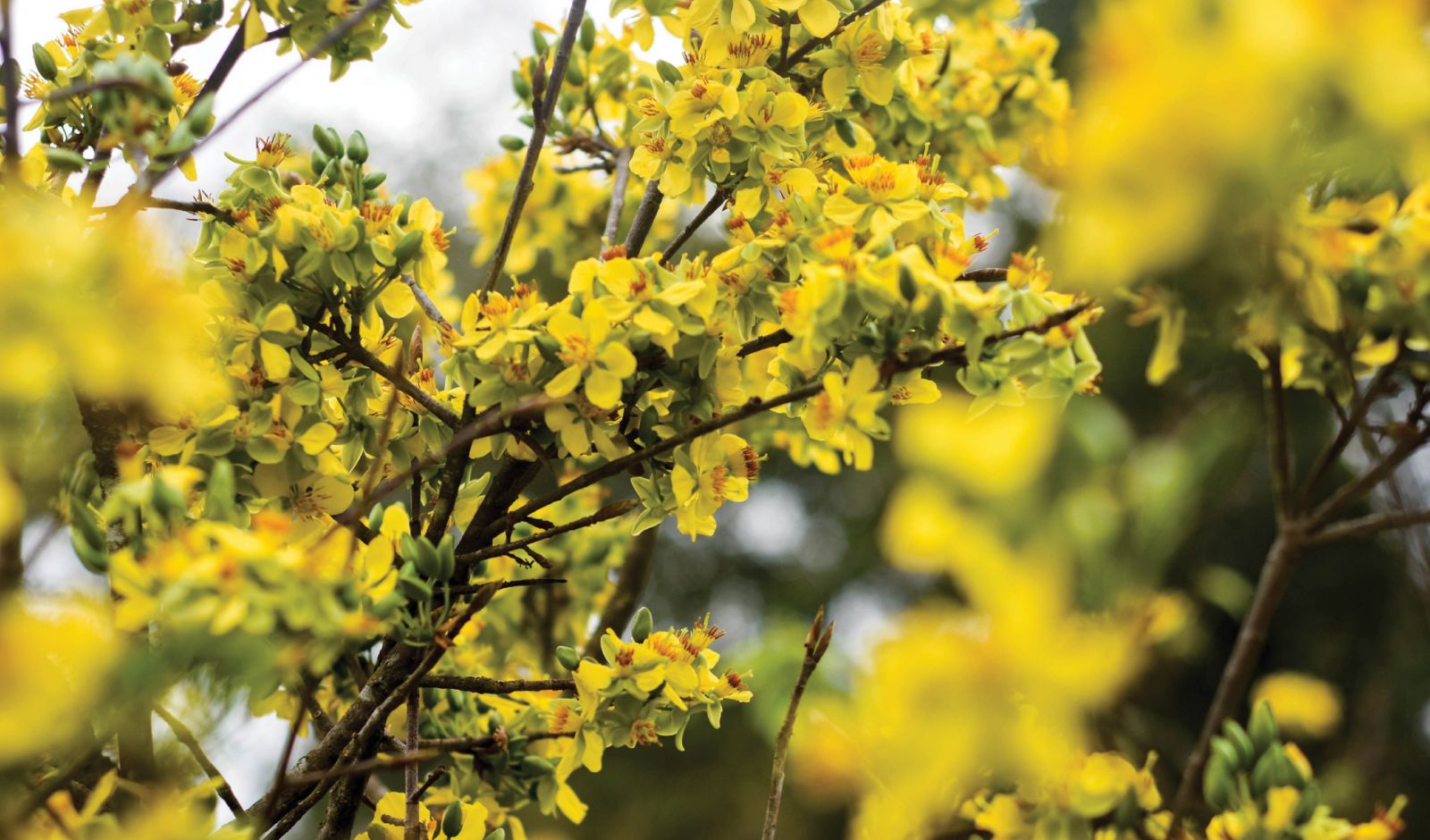
Hue yellow apricot blossom. Photo: Bao Minh
As top artisans of flowers and ornamental plants in Hue at that time, they were the elderly artisan Nguyen Huu Tung - Chief Judge of the Hue Apricot Contest, the doctor and artisan Doan Chi Thien_ one of the founders of the Hue Ornamental Flower Association in 1983, and the artisan Tran Dung _ the owner of Mai Vien (Apricot Garden.)
Those three senior artisans insisted that Hue is probably unable to compare with other cities in terms of commerce, but Hue is definitely not worse in the career of growing flowers and ornamental plants, if not better; and that talking about Hue, people immediately think of gardens, flowers and ornamental plants.
Growing flowers and ornamental plants has been an elegant hobby for Hue people since Hue was the imperial capital city. Later, it developed into a career, but after all it is always playing, playing with beauty. When one falls in love with the beauty of flowers and plants, one no longer cares much about materials. Those who do not understand would think Hue people are too proud. But one will realize it when one grows flowers and ornamental plants.
Yes, it is the idea that contributes to the Hue character. With time, it becomes the Hue spirit. As put by the writer Hoang Phu Ngoc Tuong: “Hue people prefer culture to materials; they prefer living beautifully to living in riches.
After twenty years, the skilled ornamental flower artisans of Hue such as Nguyễn Huu Tung and Tran Dung have passed away. Dr. Doan Chi Thien is still alive, but he now can only look at flowers and talks without words.
Twenty years later, rereading their stories, we come to see what they thought about flowers and trees for Hue was so essential. Any city in this world needs flowers and trees, but it seems that the need to beautify the city with them is more demanding and urgent in Hue. Without trees and flowers Hue is no longer Hue. The “Hue dream” always includes the dream of flowers.
But why do the species that have been so close to the point that they are considered traditional such as yellow apricot blossom, camellia, peach blossom, jasmine, etc., still quietly bloom and give fragrance in home gardens, but not yet in parks and on streets?
If the milk flower gives Ha Noi its identity and so does the red flamboyant in Hai Phong and peach blossom in Da Lat, then what about Hue? An ancient town used to be the main city of the Inner Realm, the imperial capital of the country, and is well known as land of garden houses and the art of ornamental flowers but trees and flowers grown in parks and on streets in Hue have not shown their identities.
Hue is famous for its yellow apricot blossom. But why hasn't it been grown on streets to create an identity? I posed that question many times but received many head shakes and objections in return.
Growing apricot blossom on streets? Many people including those working for Hue Tree and Park Center disagree with the proposal that they consider "too romantic" for an ironic reason: apricot trees planted in the garden are still stolen, let alone trees in parks and on streets. The idea of growing apricot trees on streets of Hue therefore fell into silence.
But a few years later, there appeared a yellow apricot garden in front of the Citadel and not a branch was stolen. What people saw was elegant men and beautiful women rushing to take pictures. In good weather on Tet the garden becomes vivid with yellow apricot blossom making visitors bewildered. To netizens, it is a unique check-in spot.
But still, yellow apricot trees have not been seen on streets in Hue. Was it so difficult? Experts say that trees grown in the city must satisfy requirements of environment and landscape. They must not only beautify the city, but also cool it down and benefit it. Apricot trees have wooden trunks with large canopy and they only shed leaves in late winter and give beautiful and fragrant blossom. They are hence suitable to be grown on streets. They can be grown in clusters at crossroads or together with other trees with narrow canopy so that they give shade in summer and beautiful flowers in spring.
When the Green Sunday Movement got started, we heard some negative comments doubting about it. After more than two years of diligently cleaning up the city, streets in Hue are now cleaner and people's awareness of urban environment has also improved.
When the idea of building “the city with four seasons of flowers” came up, there was more objection than consent. People worried that the harsh weather in Hue did not allow flowers all year round and that in the winter with lots of rain and wind, no plants could survive.
What flowers can ever bloom in Hue winter? That has been a repeated question for many generations so far as well as the question that someone asked me twenty years ago: “How come apricot trees are grown on streets?".
On the first days of spring 2020, the apricot trees were planted by August 23 Str. in front of the Imperial City. Mr. Phan Ngoc Tho, Chairman of the Provincial People's Committee also suggested choosing a suitable road to plant two rows of yellow apricot trees and possibly naming it Hoang Mai Street.
In spring, when apricot trees are in bloom on Hoang Mai Str., visitors from everywhere will come to Hue to welcome the spring with yellow apricot blossom in the pure and serene aroma of incense and agarwood. Hue will be then known not only for a street of apricot trees, but also as a city of yellow apricot blossom.
By Minh Tu
